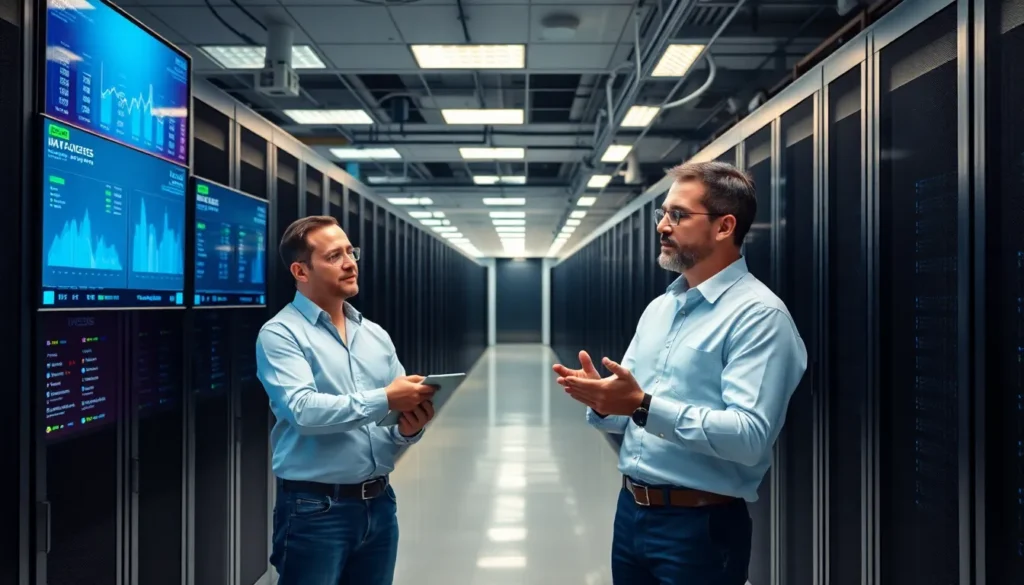In a world driven by data, cloud computing has become the superhero we didn’t know we needed. With the magical ability to store vast amounts of information at the speed of light, it’s hard to believe that this fantastic phenomenon relies on something as mundane-sounding as a data center. So, what is this mysterious data center, and why does it hold the keys to the cloud? Buckle up, because we’re about to take a whirlwind tour through the cloud, where data centers reign supreme, but don’t worry, no technical jargon here.
Table of Contents
ToggleUnderstanding Cloud Computing

Cloud computing is like renting a digital locker, except instead of housing old winter jackets, it stores everything from your treasured family photos to the latest blockbuster films. You access this digital vault through the internet, using services provided by cloud vendors like AWS, Google Cloud, or Microsoft Azure. Think of cloud computing as a buffet where you only pay for what you eat: you can scale up or down based on your needs, without committing to hefty infrastructure investments. It’s efficient, flexible, and can be immensely cost-effective for individuals and businesses alike.
What Is a Data Center?
A data center is a physical facility that houses a collection of servers, storage systems, and networking equipment. Essentially, it’s the home where data lives, breathes, and occasionally throws a party, or crashes unexpectedly. Picture a bank vault, but for digital assets. In this high-security environment, data is stored, processed, and distributed to various destinations over the internet. Due to its critical importance, data centers are equipped with robust security measures, climate control systems, and redundant power sources to ensure they remain operational 24/7.
The Role of Data Centers in Cloud Computing
Data centers are the unsung heroes of cloud computing. They deliver the backbone that supports cloud services, ensuring your emails, videos, and applications are just a click away. Without these facilities, cloud computing as we know it would simply collapse into a heap of digital chaos. By housing vast numbers of servers under one roof, data centers aggregate resources, allowing them to serve countless users simultaneously. They manage everything from data storage to running applications, all while securing sensitive information against cyber threats.
Types of Cloud Data Centers
When it comes to cloud data centers, not all are created equal. Here are the main types you should know:
- Public Data Centers: Open to anyone, public data centers serve many clients via shared infrastructure. Think of them as the communal gym for your data, affordable but crowded.
- Private Data Centers: Exclusively for one organization, private data centers offer heightened security and control. They’ re like a private gym, great for when you want to keep your secrets safe.
- Hybrid Data Centers: Striking a balance between the two, hybrid data centers combine public and private resources, offering both flexibility and security. It’s like having a gym membership and a home workout setup, best of both worlds.
- Multi-cloud Data Centers: These environments use services from multiple cloud providers, reducing dependence on a single vendor. Imagine borrowing weights from different gyms to create your perfect workout.
Each type serves unique needs, and understanding them is crucial for making informed decisions about cloud strategy.
Benefits of Using Cloud Data Centers
Cloud data centers provide numerous advantages that make them appealing to businesses of all sizes. Here are some key benefits:
- Cost Efficiency: With no need for physical infrastructure investment, companies can enjoy significant savings. Many pay only for the resources they actually use.
- Scalability: As your business grows, cloud data centers easily scale to meet increasing demands. Say goodbye to the nightmare of server overload.
- Accessibility: Data centers make information accessible from anywhere, anytime, allowing for remote work and collaboration.
- Disaster Recovery: Robust backup systems in cloud data centers help safeguard data, ensuring business continuity even in the face of disasters.
- Enhanced Security: Advanced security protocols and encryption techniques protect sensitive information better than most in-house solutions.
Challenges and Considerations
While cloud data centers come with impressive perks, they’re not without challenges. It’s essential to be aware of potential pitfalls:
- Vendor Lock-in: Relying on a specific provider can lead to complications if you want to switch vendors. It’s like getting married to your gym trainer, you might find it hard to leave if things go south.
- Downtime Risks: While they strive for 100% uptime, data centers can experience outages due to maintenance or unforeseen issues. Keeping backup plans ready is crucial.
- Compliance and Security: Adhering to regulations and maintaining data security requires constant attention and investment, as organizations deal with evolving cyber threats.
Future Trends in Cloud Data Centers
The cloud is evolving at a breakneck pace, and data centers are at the forefront of innovation. Some exciting trends to watch include:
- Edge Computing: With devices connecting to the internet every second, processing data closer to where it’s generated is becoming vital. Edge computing aims to solve the latency problem, enhancing overall efficiency.
- Green Data Centers: As sustainability concerns rise, more data centers are leaning towards eco-friendly technologies, utilizing renewable energy sources and advanced cooling techniques.
- Artificial Intelligence: AI is helping optimize data center operations, from automated management to predictive maintenance, streamlining complexities in real-time.
- 5G Integration: The introduction of 5G networks will bolster data transmission speeds, revolutionizing how cloud services are accessed, particularly in remote areas.



